A hundred thousand dead or maybe half a million? Eastern or Western Front? In which battle fought by the German army the most soldiers died? Which deserves to be called the bloodiest skirmish of the Second World War? We provide answers to your questions.
Slaughter in Crete - Operation Mercury
The struggle for Crete may not have been among the greatest battles of the Second World War, but in the struggles to capture the island, the Wehrmacht suffered some of its greatest losses in relation to its forces throughout the war. However, the very decision to capture the island was completely irrational. From a strategic point of view, Malta was a much more important goal, stuck like a thorn in the way of convoys supplying Rommel's troops in Africa. 35,000 Allied soldiers under the command of General Bernard Freyberg were stationed in Crete at that time.
In the early morning of May 20, 1941, 6,000 paratroopers of General Kurt Student's elite 11th Air Corps landed on the island for the first time. The landing party ended for the Germans, one could say tragically. The Allies successfully defended their positions. The second flight of the German paratroopers also suffered heavy losses - about half of those taking part in the action died during the landing and shortly after entering the operation. In addition, British ships completely defeated one of the German-Italian convoys transporting part of the invasion forces. The next convoy was forced to turn back.
General Freyberg, however, made fatal errors in command, as a result of which the Germans managed to capture one of the airports on the island. In addition, the Luftwaffe forces completely dominated the air. This allowed the Nazis to deliver reinforcements and take the initiative in the fight. Finally, on May 28, the evacuation of the Allied forces from Crete began.
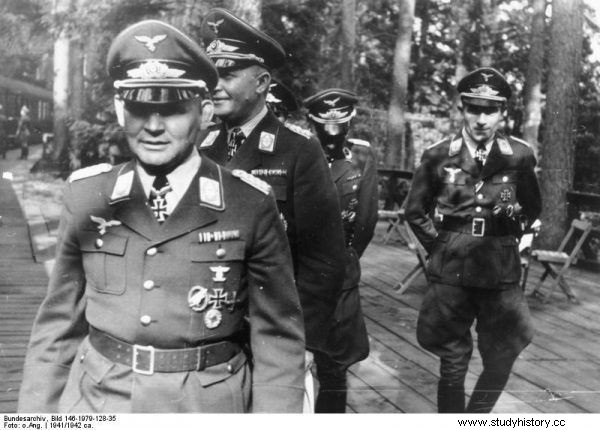
Commanders of the German Airborne Forces - Colonel Bernhard Ramcke, General Kurt Student and Major Hans Kroh - photographed in 1941.
About 13,000 soldiers were saved. The rest either died or went into captivity. For the Germans, however, it was a Pyrrhic victory. Their airborne corps suffered heavy losses of 44% of the soldiers participating in the operation . More than 3.7 thousand paratroopers were killed and around 1.3 thousand were injured. The Luftwaffe lost as many as 350 aircraft. Adolf Hitler never again allowed airborne troops to be used in such an operation. And Winston Churchill, despite the defeat, stated sarcastically that "the very point of the German lance has been broken."
Fiasco near Moscow - Operation Typhoon
In August 1941, Adolf Hitler stopped the offensive of his troops against Moscow - Kyiv was his priority goal. It was only on October 2 that units of the Army Group "Center" grouped east of Smolensk, Field Marshal Fedor von Bock, attacked the Soviet capital. They were to capture the city before the onset of winter weather. Meanwhile, the first snow fell five days later.
The German troops were also not in the best shape:the infantry divisions were thinned out, and the armored ones were short of tanks. Despite this, the Germans broke through the Soviet defense line. By 20 October, as many as 673,000 Red Army soldiers were taken prisoner in the cauldrons near Wiaźma and Bryansk. Moscow seemed to be at hand .
However, the weather deteriorated significantly and heavy rains fell. The commander of the 2nd Panzer Group, General Heinz Guderian recalled:"the roads suddenly turned into impassable mud, through which our cars could only advance at a slow pace and with excessive fuel consumption." Soviet resistance also solidified. It is true that panic broke out in the city and the government was evacuated on October 16, but Stalin remained in it, appointing Georg Zhukov as the commander of the capital's defense. Earth fortifications and anti-tank barriers began to be built around Moscow on a large scale.
German units resumed their attack on November 15. This time, the invaders were hit by severe frost, which was 20 degrees, and with time it increased significantly. The Wehrmacht was not prepared for such an eventuality. Winter clothing was scarce, weapons and vehicles refused to obey. As many as 228,000 soldiers suffered from frostbite. The situation was made even worse by the Soviet counter-strike on December 5. The German offensive slowed down. Only the German leaders reached, or actually dragged along, a few kilometers from the outskirts of Moscow. The Wehrmacht is stuck for good.
The German losses in the Battle of Moscow were terrifying. Only from November 15 to December 4, 85,000 Germans died on the front near the Soviet capital . This was the cost of the entire Eastern Front from the start of Operation Barbarossa to mid-November. And that was not the end of the losses - another 30,000 died in the Tula area. Hitler, however, as Peter Longerich writes in his biography of the Leader of the Third Reich entitled "Hitler" , disregarding the victims, he ordered:"hold positions and fight to the end." In addition, he dismissed many of the top Wehrmacht commanders and took command of the German ground forces himself.
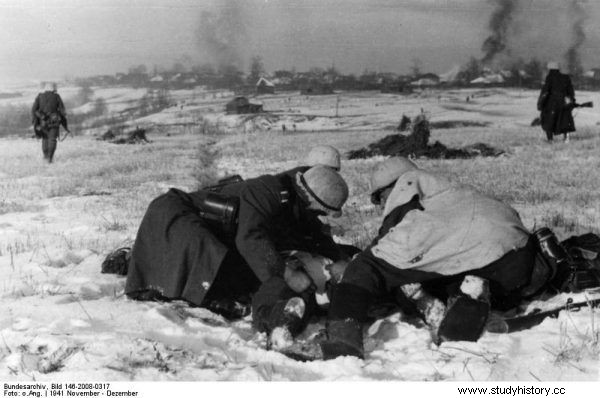
German troops were not prepared for the winter attack and got stuck near Moscow.
The Stalingrad disaster
The defeat at Stalingrad most vividly exposed Adolf Hitler's dilettantism as a military commander. Of course, ordinary soldiers had to pay for his mistakes with their lives. In the summer of 1942, the Führer dreamed of conquering the oil-bearing region of the Caucasus and the city of Stalingrad on the Volga River at the same time. Therefore he divided his forces.
It was pure madness, because the targets of the attack were in different directions of impact and at a considerable distance from each other. Two German armies moved to the Caucasus, while three armies moved towards Stalingrad (a target of much less strategic importance). Hitler was deaf to the protests of his commanders.
The offensive began on June 28, 1942 and was initially successful. Stalin was so concerned about the progress of the German troops that on July 28 he issued his famous order:"Not a step back!". On August 21, 1942, General Friedrich Paulus ordered his powerful 6th Army to launch an attack on Stalingrad. Four days later, its troops reached the Volga north of the city. A fierce struggle for the fortress named after Stalin took place for many weeks. Unexpectedly, on November 19, the Soviets launched a counteroffensive. This resulted in the encirclement of the 6th Army and the entrapment of 284,000 German and Romanian soldiers in a cauldron.
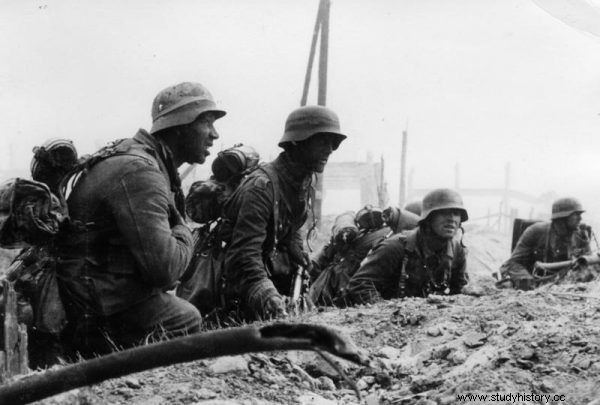
German infantry during the street fighting in Stalingrad in September 1942.
As near Moscow, the weather soon took its toll on the Germans. Supply shortages appeared. Also the Red Army soldiers were not idle, and the Soviet artillery and air force bombarded targets in the area of the increasingly shrinking cauldron every day. Pancerniak Ernst Panse recalled:
The Russians pressed us with far more powerful units, especially tanks with infantry support. From then on, our home was only the bare steppe. Day after day, sharp, icy winds blew in our faces. The snow was still bearable in terms of quantity, but in the blizzards and harsh winds it became hell.
Finally, on February 2, 1943, six months after the start of the struggle for Stalingrad, the German troops capitulated in the cauldron. 146,000 soldiers died in combat, starved to death or froze. The Luftwaffe, trying to provide air to its encircled companions, suffered heavy losses - over 8,000 people of flying and ground personnel were killed. Out of 108,000 prisoners of war in Soviet captivity, more than half then died of typhus in the camps. Thus ended Hitler's obsession with the capture of Stalingrad. From that moment on, the German army lost the initiative on the Eastern Front .
Red Tsunami - Soviet Operation Bagration
In the spring of 1944, Stawka - the Soviet High Command - decided that the defeat of German troops in Belarus was a priority this summer. The operation was prepared on a grand scale. By simultaneous strike by the forces of four fronts, it was planned to take back Belarus, western Ukraine and part of Poland and Lithuania from the enemy's hands. In total, 2.4 million soldiers, over 36,000 guns and mortars, 5,200 tanks and 6,300 combat aircraft were to take part in the offensive.
Operation Bagration began on June 23, 1944. Soviet troops broke the front 350 km long and advanced 300 km west by the end of the month. The German Army Group Center almost ceased to exist after two of its armies were destroyed and a third was encircled.
The Soviets could oppose the remaining "Middle" 16 German divisions with 132 divisions as well as 62 brigades and armored regiments. At the end of July, the Red Army stood in the north on the border of East Prussia, in the central part of the front near Warsaw, and in the south near Belgrade!
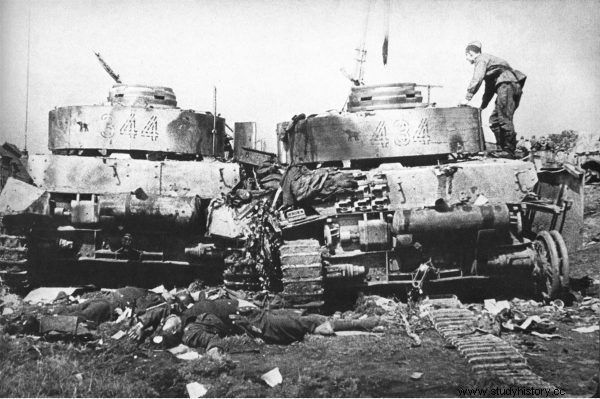
A pogrom was awaiting the Germans during Operation Bagration. The photo shows the destroyed tanks and their dead crew near Bobruisk.
Until August 29, when Operation Bagration officially ended, the Soviet troops on the 1,000-kilometer front had advanced up to 600 km deep into the enemy's territory. The pogrom of the German army was absolute and had no equal in this war. The Third Reich lost 400,000 soldiers:killed, wounded, missing and captured. Some sources say losses of up to 670,000 people! One of the Nazi generals stated at the time that "the break-up of Army Group Center put an end to the organized German resistance in the East" .
Battle for Berlin
The Soviet attack on Berlin began on April 16, 1945. The Red Army deployed even greater forces to this battle than during Operation Bagration. It was 2.5 million soldiers, 41,000 guns and mortars, 6,200 tanks and 7,200 aircraft . The German army, chasing after the remnants of its forces, numbered 300,000 soldiers, a large part of which were the Volkssturm and young people from the Hitlerjugend. Adolf Hitler then issued a memorable proclamation in which he vividly described the consequences that would befall the German people when the Bolsheviks entered their lands. Its excerpts are quoted in his recent biography of the Führer entitled "Hitler", Peter Longerich :
"Old men and children will be murdered, and women and girls will be humiliated as barracks harlots. The rest will march to Siberia. " But he also wrote:"This time the Bolsheviks will face the eternal fate of Asia, that is, they will bleed out at the gates of the capital of the German Reich."
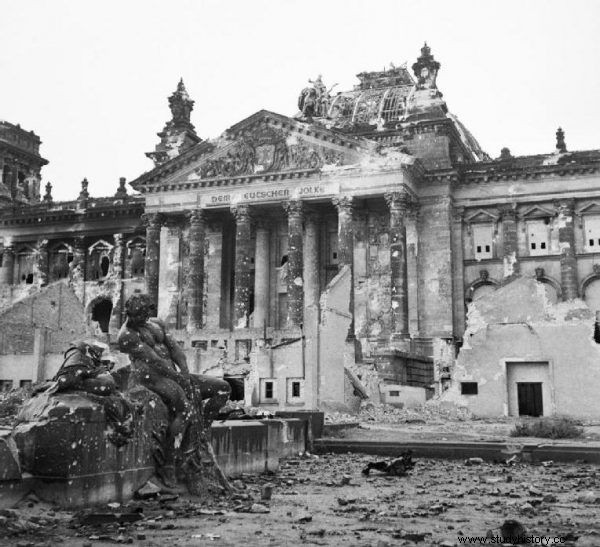
After the Red Army had moved from Berlin, ruins remained. The photo shows the ruins of the Reichstag and the surrounding area.
The Chieftain's prophecy had failed, at least not for the latter part. In a murderous city battle, Red Army soldiers and Polish soldiers conquered successive quarters of Berlin streets, meter by meter. The city was in ruins:this was the result of massive artillery and air bombardments by the Allies from the east and west. The more significant Nazi dignitaries tried to save their skin, while Hitler stayed until the end. On May 2, Berlin surrendered.
In this last battle, the German losses were enormous. It is estimated that they could reach up to half a million fallen, missing, wounded and captured soldiers and civilian Berliners .
